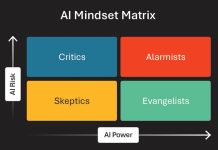A seamless beginning-to-end positive customer experience is crucial to buyers and will shape the sales landscape in the years ahead, shifting the focus away from tried-and-true benchmarks like price alone. That sort of customer experience includes everything from billing to website navigation, an all-encompassing sentiment that factors in the interactions and platforms used between buyer and seller.
The six characteristics below help to define whether an organization will prosper in the ultra-competitive CX landscape.
Customization
As author and business leader Ben Lytle wrote in his book “The Potentialist: Your Future in the New Reality of the Next Thirty Years,” “Consumers want custom, personalized results instead of standardized commodity goods and services. They want to become what author Alvin Toffler called ‘a market of one.’”
That CX customization should extend not just to the products or services, but also the purchasing journey. Some customers know what they want and how much they want to pay.
Others, however, “aren’t motivated to make big decisions at the start. Instead, they’re eager to get a taste of excitement as soon as possible. Only later, once they’ve become more involved in the journey, are they willing to invest in a major purchase or subscription,” Ahir Gopaldas and Anton Siebert wrote for Harvard Business Review in 2022. The challenge for companies is cueing purchasing decisions at the perfect time.
B2B buyers can have very diverse and unique demands, and it’s vital that they get customized, personalized care. They’re interested in more than just products and don’t want to be treated like every other similar business. They want to build a relationship.
Consumer Emphasis
A focus on CX means putting yourself in the customer’s shoes and viewing their interactions — and possible pain points – with solutions in mind, no matter where they are in your sales funnel. Their interactions should be efficient and effective, useful and enjoyable.
Streamlining processes and platforms to meet consumer needs can be especially difficult for large organizations and those with legacy systems.
“At its heart, customer experience is about understanding the customer and being willing and having the capability to adapt your processes, your products, your services, so that they meet those customer expectations, goals, and desires.”
—Michael Krigsman
Industry analyst and host of executive discussion platform CXOTalk, told Harvard Business Review
Customer experience requires a mindset shift and a culture centered on real-time insights and agility. Without that agility, competitors are liable to develop more effective CX strategies, cutting into your company’s market share and eroding your customer base. It also requires a deep commitment to understanding customer needs and recognizing emerging opportunities.
Price is certainly an important factor for B2B buyers, but it isn’t the only factor. There could be barriers and pain points and delays and inventory problems driving them to consider other options.
Customer loyalty only goes as deep the customer’s satisfaction. If a buyer’s experience doesn’t match their expectations or a seller can’t deliver, the buyer is liable to pursue other options now or when their contract is up for renewal.
Strong consumer emphasis requires unity between marketing and sales. Where B2B funnels have typically involved marketing generating leads and sales working with those leads, future B2B is poised to see marketing and sales working more closely alongside one another, with marketing “leading the B2B organization’s quest to identify opportunities, architect strategies, orchestrate execution, and ensure profitability revenue growth, through a relentless focus on delivering value to existing and future customers and stakeholders,” according to a May 2021 report on future B2B marketing written by Lori Wizdo for Forrester.
Maintaining a consumer emphasis is tantamount. From there, all things are possible.
Choice
Choice is great when you’re an individual customer buying clothes—and in the future, customers will effectively be able to choose which items get displayed in their own personalized storefronts.
But more choice isn’t always so helpful when it comes to B2B sales, when buying decisions can involve lots of stakeholders and long-term planning. Too many options can lead to “analysis paralysis” and second guessing.
Thus, the need for prescriptive and easy selling—cutting through to the customers’ needs, providing recommendations to fulfill those needs, envisioning pain points and purchasing hurdles, and working on ways to sidestep those obstacles.
The easier the buying process, the less likely that any hindrances, including choice, will get in the way.
Direct and Instant
Successful businesses will flatten and remove the steps between the consumer’s decision and fulfillment.
The customer should feel like they are directly involved in the design of the product, or that their insights are being taken into account.
It’s empowering for customers to be able to guide their own buying process. And if they want to speak to someone because they have an issue or a question, that option is available, too, first through AI chat and next, through human interaction.
Collaborative
Customers’ voices will ring louder and louder. Consumer feedback — in the form of customer ratings and reviews — will fuel or inhibit purchasing decisions and influence improvement. Polls, chatbots, AI and social media interactions provide opportunities for feedback and communication.
Crowdsourcing is also becoming more popular for companies wishing to test products with customers. You wouldn’t think of a corporate giant like Coca-Cola in terms of start-up culture, but the iconic company in recent years launched a crowdsourcing forum to, among other things, “embrace an agile, test-and-learn mindset.” Employees develop and pitch product ideas to a panel of senior company leaders, and winning ideas are given a market trial.
Other companies such as LEGO, Starbucks and NASA have also used crowdsourcing to develop new products, innovations and experiences.
Such efforts give customers a sense of input on product offerings and let them know that they are being heard.
Maturational
Democratization doesn’t happen overnight. It happens “in stages with time and experience, much like personal maturity,” Lytle writes. As such, it requires steady, consistent innovation. Products and services are refined and improved.
We’ve only scratched the surface on the potential of cloud-based technologies and their impact on sales. But progress has been encouraging.
Retailers have begun launching digital dressing rooms where your personal avatar, from the privacy of your home, can try on as many items as you wish. There’s no worry about deceptive mirrors or a door that doesn’t seem to lock.
The insights gathered by sellers will help to make the buying process more informed and more personal. Data and insights will fuel reforms and innovations, and CX innovations will become industry standards, creating new baselines for customer experience expectations.
Through continuous innovation and improvement, the impossible will soon become possible, with entirely new services and products helping to cement customer loyalty and foster long-term relationships.




